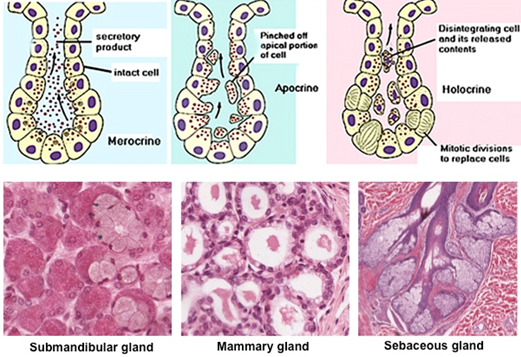Modes of cellular secretion
Let’s now consider the three main
mechanisms by which exocrine glands release their secretory
products:
- Merocrine (aka, eccrine)-
secretory vesicles fuse with the apical plasma membrane to
release their products into a duct (e.g. secretion of saliva by
salivary glands). Take a look at this specimen of the
submandibular gland, which uses the merocrine mode of secretion.
- Apocrine- secretory products are
released at the apical cell surface in small membrane bound
vesicles that enter into a duct (e.g. secretion of lipid
droplets in the mammary gland). Take a look at this
section of
lactating breast and the image below. Note the lipid droplets
and protein-rich secretions within the lumens. Mammary glands
also use the merocrine mode for secretion of milk proteins.
- Holocrine- secretory products
accumulate in the secretory cells, which then die and the entire
cell and its secretory products are released into a short duct
(e.g. secretion of an oily, lipid-rich product by sebaceous
glands in the skin). Check out the
sebaceous glands of the skin
and the image below to see the holocrine mode of secretion.
Lipids are extracted during tissue processing, resulting in pale
staining within the secretory cells.
 Now let's consider
endocrine glands. |